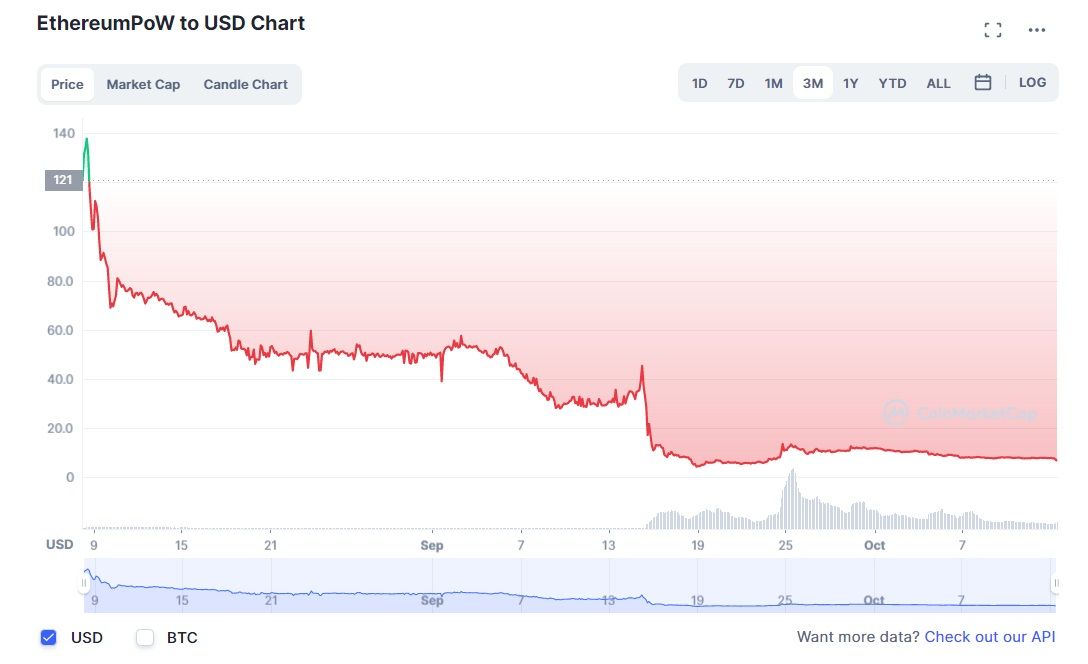Ethereum is the most widely used blockchain in existence and the second-most popular cryptocurrency in the world, next to Bitcoin. But, like Bitcoin, various Ethereum derivatives serve different functions, including Ethereum Classic (ETC) and Ethereum Proof of Work (ETHW). But what, exactly, is the difference between ETC and ETHW? What is their purpose, and are they useful?
What Is Ethereum Classic (ETC)?
As the name suggests, Ethereum Classic was the first Ethereum blockchain to be developed. This blockchain is now used to run smart contracts, programs that run when predetermined conditions are met between a buyer and a seller. The Ethereum Classic network came to be via a hard fork in July 2016 after tensions began to rise between users with differing views within the network.
In 2016, an Ethereum-based project known as The DAO (Decentralized Autonomous Organization) was hacked through a code exploit, with $50 million in investor money being stolen. The Ethereum community could not agree on how users should be compensated for the loss.
Some wanted the blockchain to be reversed, including Ethereum co-founders Vitalik Buterin and Gavin Wood, while others believed that the ledger should remain immutable (which aligns with cryptocurrency’s ideology). In the end, a compromise was reached, which led to the Ethereum Classic hard fork.
Those who were for the fork moved over to the main version of Ethereum most people know and use, with those who were against it remaining on the original chain, which was renamed Ethereum Classic. A group of miners decided they would be responsible for taking Ethereum Classic in a different direction to Ethereum while preserving the original code. As a result, Ethereum Classic doesn’t follow updates on the Ethereum blockchain, such as the Ethereum 2.0 Merge.
This blockchain’s native currency is also known as Ethereum Classic (ETC). Like Ethereum, Ethereum Classic can also be used to develop decentralized applications (DApps) that can use native ERC-20 tokens.
Ethereum Classic Mining
Ethereum Classic became particularly popular throughout Summer 2022 due to the Ethereum proof of stake blockchain merge. Because the Ethereum blockchain has switched from proof of work to proof of stake, miners are no longer required to verify transactions. Instead, Ethereum will use validators to secure the blockchain.
This means that thousands of miners are now looking for a new coin to make a profit on. Enter Ethereum Classic.
Ethereum Classic still runs using a proof of work consensus, can be mined using both GPUs and ASICs, and can be profitable.
The Ethereum merge also gave way to a new blockchain known as Ethereum Proof of Work. So, how does this differ from Ethereum Classic?
What is Ethereum Proof of Work (ETHW)?
Ethereum Proof of Work (ETHW) came as a result of the long-anticipated Ethereum Merge. The main Ethereum blockchain used the proof of work consensus mechanism, which required miners to work. Miners would solve complex mathematical problems to verify blocks containing transactions and would be rewarded for doing so.
However, Ethereum planned to switch to the proof of stake mechanism for a long time, as this is a more energy-efficient protocol.
Furthermore, one of the biggest issues associated with the Ethereum blockchain is gas fees, which can be very high depending on the state of the network. Gas fees are paid to make up for the computational power required to run the network. So, with a more energy-efficient consensus mechanism, these fees could be lowered (though lower fees aren’t expected to kick-in until later updates to the Ethereum PoS blockchain introduce gas-saving tech like blockchain sharding). On top of this, switching to proof of stake can help Ethereum become more environmentally friendly overall.
But not everyone is happy about the Ethereum 2.0 Merge, most notably the miners who are now out of pocket. So, along with Ethereum Classic, Ethereum Proof of Work can also be mined for a profit.
The main purpose of Ethereum Proof of Work is to allow previous Ethereum miners the chance to still earn a profit. A miner, Chandler Guo, developed Ethereum Proof of Work to accommodate miners out of work due to the Merge. Ethereum Proof of Work has a native coin, known as ETHW.
The price of ETHW surged to almost $140 after its launch in August 2022, but has since decreased to around $9. Such fluctuations aren’t unusual for a brand-new crypto, though there’s no knowing how its price will perform in the coming months. Such is the nature of the cryptocurrency industry!
Overall, the Ethereum Proof of Work blockchain sounds like good news for miners, but it has already faced a significant challenge associated with its chain ID. Ethereum Proof of Work uses the same chain ID as a Bitcoin Cash (BCH) testnet, meaning the MetaMask software wallet could not decipher which blockchain was which.
Ethereum Proof of Work Mining
ETHW mining is a very new venture and can be done using either an ASIC miner or GPU. An array of ETHW mining pools have already been created for new miners. Most notably, Binance now allows users to mine Ethereum Proof of Work via Binance Pool. ETHW mining rewards can be converted to Binance USD or Tether via Binance Convert, which are both stablecoins. 2miners also now offers an ETHW mining pool.
However, Binance has not yet listed Ethereum Proof of Work for trading. Most other well-known crypto exchanges have also not added ETHW for trading. At the moment, ETHW seems to be solely a mining reward coin above all else.
ETC vs. ETHW: What Will You Mine?
While both Ethereum Classic and Ethereum Proof of Work use the same consensus mechanism, the two blockchains are certainly not one and the same. Ethereum Classic can offer you both a blockchain for building DApps, and a solid mining option, while Ethereum Proof of Work mainly serves as a reward crypto in the mining process. But either of these blockchains and cryptos could be suited to you, depending on what you want to do in the crypto industry.



